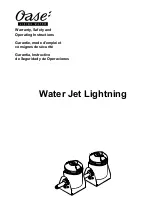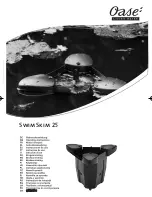
SAFETY WARNINGS
HIGH PRESSURE FLUID CAN CAUSE SERIOUS INJURY. FOR PROFESSIONAL USE ONLY.
OBSERVE ALL WARNINGS. Read And Understand All Instruction Manuals Before Operating Equipment.
MOVING PARTS HAZARD
KEEP HANDS AND FINGERS AWAY FROM THE PRIMING PISTON
DURING OPERATION AND WHENEVER THE PUMP IS CHARGED
WITH AIR to reduce the risk of injury!
On the pump downstroke the
priming piston extends beyond the intake valve housing to pull the mate-
rial into the pump. The priming piston works under extreme force. During
operation and whenever the pump is charged with air, the priming piston
can severely injure or amputate a hand or finger, or break a tool, caught
between it and the intake valve housing. Always follow the
Pressure Re-
lief Procedure
, below, before checking, clearing, cleaning, flushing or
servicing any part of the pump.
The air motor piston and fluid piston (located inside the air motor cylinder
and coupling) also move when air is supplied to the motor. Do not place
your hand or fingers into the air motor coupling cavity while the pump is
operating. Before servicing the pump, follow the
Pressure Relief Proce-
dure
below to prevent the pump from starting accidentally.
As the ram is raised and lowered, the wiper plate, ram tubes, and pump
mounting bracket move. To reduce the risk of pinching or amputation of
fingers, keep your hands away from the wiper plate, lip of the fluid can,
pump bracket and ram tubes while the ram is operating. Do not shut off
the air supply to the ram while it is raised. Doing so will cause the pump to
fall uncontrolled to the bottom.
EQUIPMENT MISUSE HAZARD
Pressure Relief Procedure
To reduce the risk of serious bodily injury, including fluid splashing
in the eyes or on the skin, or injury from moving parts, always follow
this procedure whenever you shut off the pump, when checking or
servicing any part of the dispensing system, when installing,
cleaning or changing nozzles, and whenever you stop dispensing.
1. Shut off the dispensing valve.
2. Shut off the bleed–type master air valve (required in your sys-
tem), on the main air line.
3. Close the bleed–type master air valve (supplied with your
pump).
4. Trigger the dispensing valve to relieve pressure.
If you suspect that the dispensing valve, nozzle or hose is com-
pletely clogged, or that pressure has not been fully relieved after
following the steps above, VERY SLOWLY open the pump bleeder
valve, having a container ready to catch the drainage. Leave the
pump bleeder valve open until you are ready to dispense again.
VERY SLOWLY loosen the hose end coupling and relieve pres-
sure gradually, then loosen completely. Now clear the nozzle or
hose.
General Safety
Any misuse of the dispensing equipment or accessories, such as
overpressurizing, modifying parts, using incompatible chemicals and flu-
ids, or using worn or damaged parts, can cause them to rupture and result
in fluid splashing in the eyes or on the skin, or other serious bodily injury,
or fire, explosion or property damage.
NEVER alter or modify any part of this equipment; doing so could cause it
to malfunction.
CHECK all dispensing equipment regularly and repair or replace worn or
damaged parts immediately.
Always wear protective eyewear, gloves, clothing and respirator as rec-
ommended by the fluid and solvent manufacturer.
System Pressure
NEVER exceed the maximum fluid working pressure of 60 bar (850 psi)
or the maximum air inlet pressure of 7 bar (100 psi). Refer to the
TECHNI-
CAL DATA
on page 18.
Be sure that all dispensing equipment and accessories are rated to with-
stand the maximum working pressure of the pump. DO NOT exceed the
maximum working pressure of any component or accessory used in the
system.
Fluid Compatibility
BE SURE that all fluids and solvents used are chemically compatible with
the wetted parts shown in the
TECHNICAL DATA
on page 18. Always
read the manufacturer’s literature before using fluid or solvent in this
pump.
HOSE SAFETY
High pressure fluid in the hoses can be very dangerous. If the hose devel-
ops a leak, split or rupture due to any kind of wear, damage or misuse, the
high pressure spray emitted from it can cause fluid to splash in the eyes
or on the skin, or other serious bodily injury or property damage.
TIGHTEN all fluid connections securely before each use. High pressure
fluid can dislodge a loose coupling or allow high pressure spray to be
emitted from the coupling.
NEVER use a damaged hose. Before each use, check the entire hose for
cuts, leaks, abrasion, bulging cover, or damage or movement of the hose
couplings. If any of these conditions exist, replace the hose immediately.
DO NOT try to recouple high pressure hose or mend it with tape or any
other device. A repaired hose cannot safely contain the high pressure
fluid.
HANDLE AND ROUTE HOSES CAREFULLY
. Do not pull on hoses to
move equipment. Do not use fluids which are not compatible with the in-
ner tube and cover of the hose. DO NOT expose Graco hoses to tem-
peratures above 82
C (180
F) or below –40
C (–40
F).
IMPORTANT
United States Government safety standards have been adopted under the Occupational Safety and Health Act. These standards – particularly the Gen-
eral Standards, Part 1910, and the Construction Standards, Part 1926 – should be consulted.



































